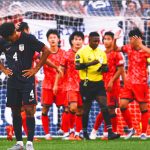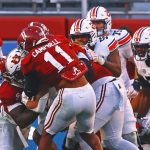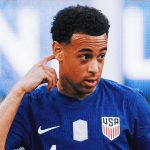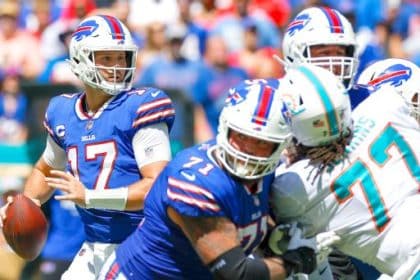With just over two minutes left in Game 3 against the Brooklyn Nets, Tyrese Maxey danced with the ball at the top of the key. His Philadelphia 76ers trailed by five. James Harden — the man normally tasked with creating shots in these situations — was watching the action from the visitor’s locker room in Barclays Center after being ejected. Joel Embiid, the man normally tasked with hitting shots in these situations, had no lift or burst after hurting his knee earlier in the game.
It was all on Maxey. The Sixers had won the first two games of their first-round matchup. Another victory would snatch any hope the Nets had left. Embiid set a screen. The action confused the Nets’ defense. Maxey crossed to his left, rose up from behind the 3-point line and buried a jumper.
A little over a minute later, with the game tied, he was back in a similar spot. He danced with the ball at the top of the key again, planted his left foot into the hardwood, freezing Nets guard Spencer Dinwiddie. The hesitation was all Maxey needed. He stepped back behind the 3-point line and flicked the ball into the air. It splashed through the net, giving Maxey his fifth 3-pointer of the night and the Sixers a game-sealing three-point lead.
Later that night, Nets guard Seth Curry, who played alongside Maxey in Philadelphia for more than a season and who’s one of the most accurate 3-point shooters in NBA history, was asked about his former teammate’s performance.
“He’s a knockdown shooter now,” Curry said.
The “now” was necessary, because not that long ago, Maxey appeared to be a bad 3-point shooter. As a rookie with the Sixers, he rarely attempted shots from deep (just 1.1 per game). When he did, they rarely went in (30.1%). It’s not like this was a blip on the radar either. The year before, as a freshman at Kentucky, he connected on just 29.2% of his deep looks — and that was when launching 3.6 per game.
Yet the Sixers were never concerned. In their view, there were plenty of reasons to believe that Maxey’s numbers were misleading, that not only was he not a bad shooter but that he was actually a good one. That present percentages didn’t determine a player’s future shooting potential. Maxey, just 22 years old and wrapping up his third NBA season — one in which he drilled 43.4% of his 3-pointers during the regular season and 50% in the first round — is proving them right.
ADVERTISEMENT
In Tuesday night’s Game 5 of the team’s semifinals series with Boston, Maxey’s shooting broke the Celtics’ momentum multiple times. After the Boston crowd started to get behind a run in the fourth quarter, Maxey buried a 3 with a little over nine minutes to go to quiet them and steady the ship.
He then hit a dagger with under four to go. He finished with 30 points on 10-of-21 shooting, including 6 of 12 from long distance – a welcome sign after slipping beneath 30% for the series. With the 115-103 win, the Sixers now have a 3-2 lead with a chance to clinch at home Thursday.
“I’ve worked all my life at shooting the ball,” Maxey said after a Sixers practice in late April. “I’ve always been a pretty good shooter.”
As a kid, Maxey would do shooting drills with his father, Tyrone, a former Division I player and high school basketball coach. He’d go spot to spot around the perimeter, and “He’d always hit at least seven out of 10,” Tyrone said. By high school, the jumper had developed into one of Maxey’s strengths. So much so that, according to his former AAU coach, Josh Woodson, Maxey often pulled up from deep on game-winning shots instead of taking the ball to the rim.
“His dad would be on him after that,” Woodson said between laughs. “He’d be like, ‘Boy, you’ve got a clear lane to the rim. What’s wrong with you?’”
That’s why Maxey’s family and coaches were perplexed by his shooting struggles at Kentucky. Tyrone remembered being asked by friends why his son suddenly couldn’t hit a jumper. Even Tyrese, an exuberant optimist who Sixers head coach Doc Rivers has compared to “sunshine,” called his dad at one point to ask the same question.
“I said, ‘Just keep working, you’re a great shooter,’” Tyrone recalled.
But as the Sixers conducted their homework in the lead-up to the 2019 draft, they believed there were explanations lurking beneath the surface, reasons to believe that the numbers were misleading. Maxey was both an eager learner and a hard worker, two traits that, at the NBA level, often lead to shooting improvements. Also, at Kentucky he usually played alongside two paint-bound big men, an alignment that limited Maxey’s space to create and bogged down the offense. Plus, a bunch of Maxey’s 3-pointers had come with the shot-clock running out after a teammate had failed to generate a look.
“We wanted to get tough 2s,” Maxey said. “[Kentucky head coach John Calipari] is big on 2s. So I shot, like, a lot of late-clock 3s.”
The Sixers scooped up Maxey with the 21st pick in the 2020 draft. That offseason, he started coming into the team’s Camden, N.J. facility so frequently and so eagerly that a member of the coaching staff, suspicious of Maxey’s over-exuberance, called up Kenny Payne, an assistant coach during Maxey’s year at Kentucky, to ask, “Is this all an act, or this kid for real?” Eventually the team instituted mandatory “black out days” for Maxey — otherwise, he’d never take a day off.
During those extended gym hours, the Sixers watched Maxey put up thousands of jumpers. Most went in. It’s why they remained confident in his ability to grow into a good shooter — even as they watched him miss 70% of his 3-pointers and score just eight points in 15.3 minutes per game as a rookie, and even as his reluctance and struggles from deep allowed defenders to sag off of him, clogging the lane for Maxey’s teammates. The Sixers offense was five points per 100 possessions worse with Maxey on the floor during the 2020-21 season, according to Cleaning the Glass.
“I’ve never seen a guy shoot like that in practice and have it not translate (to games),” Rivers said in an interview last year.
After the season, Maxey spent time with one of his trainers, Tim Martin, tweaking his mechanics. One focus was adding arc to Maxey’s shot. Another was making sure Maxey set his feet before shooting.
“Most players pick up their dribble too early when going into a shot and their feet are still moving,” Martin said in an interview last year. “For Tyrese, it was about making sure he was getting one into the ground before getting into the shot.”
That fall, Ben Simmons, the team’s perennial point guard, refused to report to training camp, making Maxey the team’s primary ball-handler. With that came more minutes and from there, Maxey said, he was able to develop a rhythm.
“My rookie year I didn’t play a lot,” he said. “I didn’t have a lot of opportunities.”
Maxey excelled in that job. He more than doubled his scoring (17.5 points per game). He finished the season with the third-best 3-point shooting percentage in the league, and when the Sixers acquired the ball-dominating James Harden before the 2020 trade deadline, bumping Maxey into more of an off-ball role and making his outside shooting became even more essential, Maxey just kept making shots.

This season, he upped his scoring to 20.3 points per game. He was the league’s fifth-most accurate 3-point shooter. Celtics big man Al Horford was the only player to launch more than five per game and connect on a higher percentage. The Sixers offense was 4.1 points per 100 possessions better with Maxey on the court, according to Cleaning the Glass, and during the playoffs that number has rocketed up to 12.
“I can draw my defender out, the way I shoot the ball off the catch and off the dribble, guys have to respect that,” Maxey said. “So now I can kind of get to my driving lanes, get to the rim, get to my floater or get to that paint, collapse the defense and kick it out.”
These days, the Sixers’ only complaint with Maxey is one that just three years ago would have seemed unfathomable.
“They’ve been on him about shooting,” Tyrone said. “He shoots the ball so well, they want him to shoot even more shots.”
Yaron Weitzman is an NBA writer for FOX Sports and the author of Tanking to the Top: The Philadelphia 76ers and the Most Audacious Process in the History of Professional Sports. Follow him on Twitter @YaronWeitzman.
NBA trending
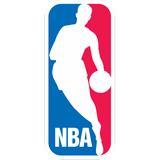
Get more from National Basketball Association Follow your favorites to get information about games, news and more



